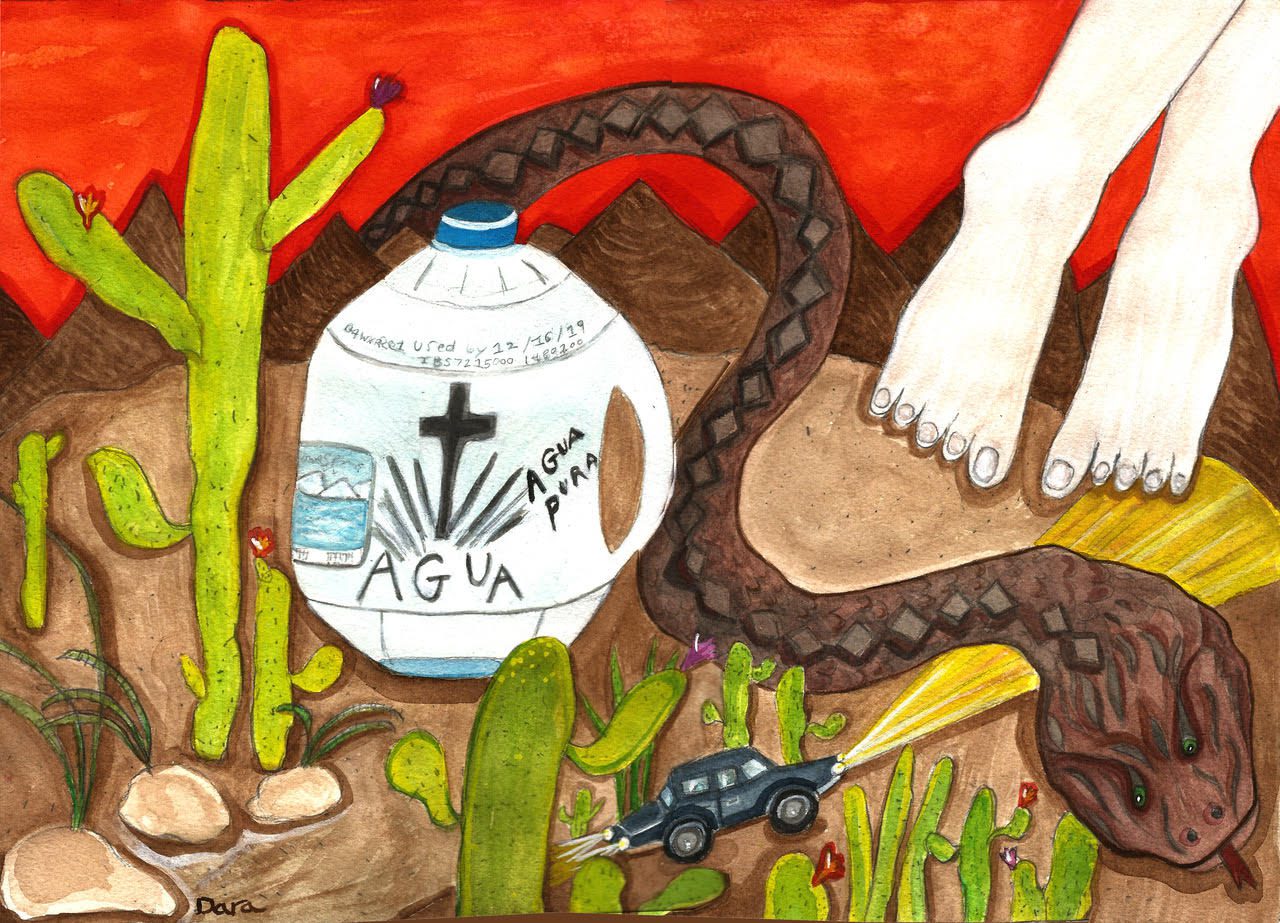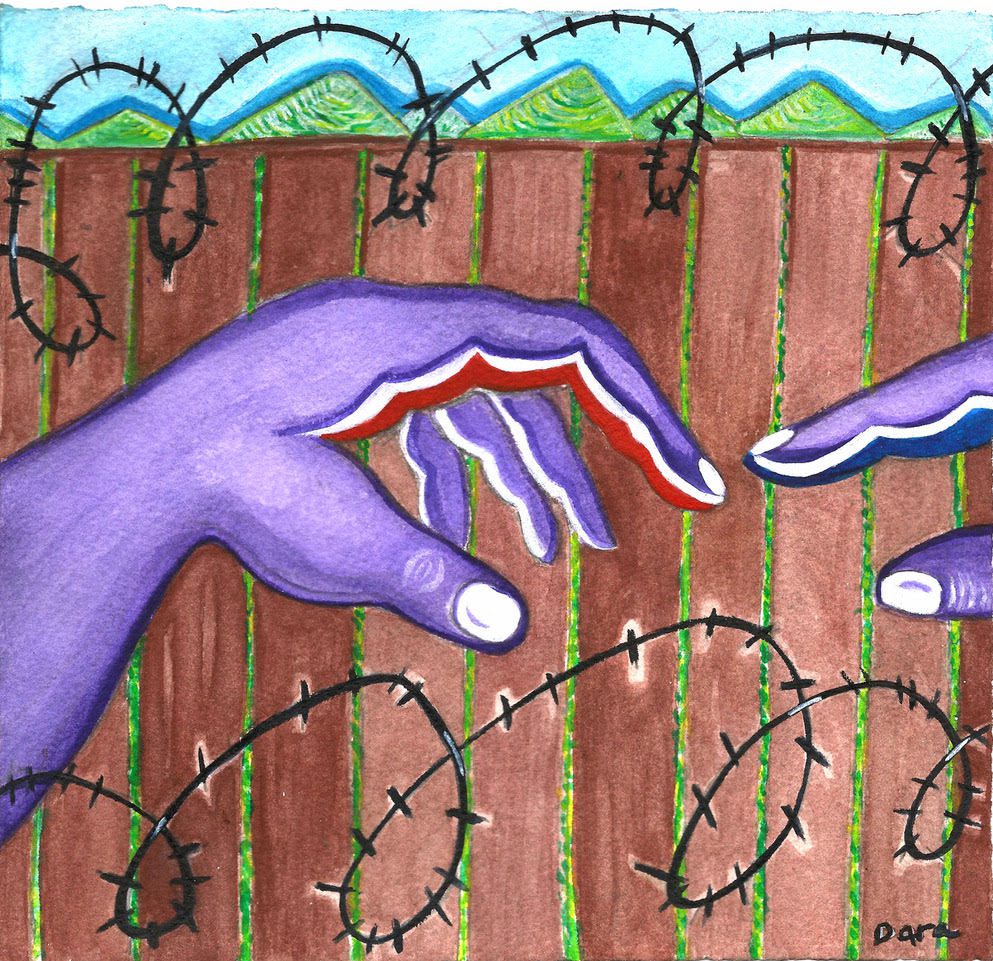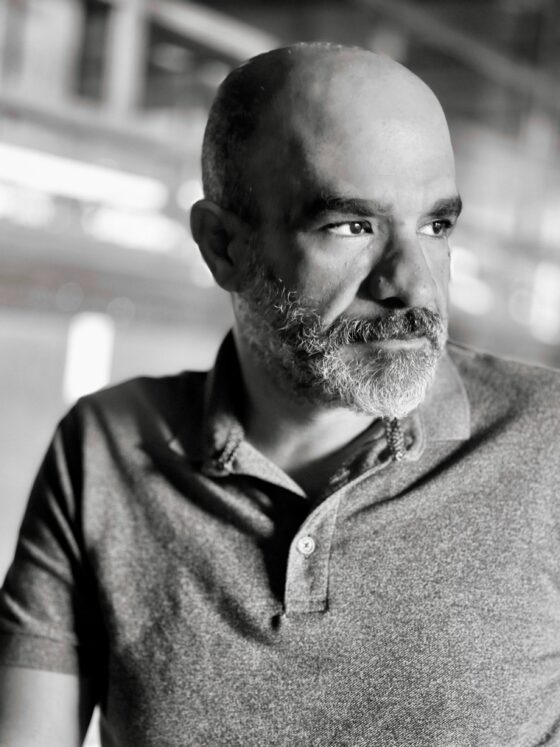
The hour before what might have been our first kiss was perfect. I made a beautiful dinner. The dog pressed his furry cheek against the painter’s leg while I cooked, beside himself that he had managed to win her over in such a short time. I was about to open a bottle of wine when I looked out the kitchen window, and the sky was on fire.
I dumped the appetizers in Tupperware and pulled two plastic tumblers from the cabinet. “Grab that blanket,” I said. “Let’s go.”
I have always loved the courtship phase, but there were so many things working against me that night. First, there was the very public unraveling of my life on another continent, a story so strange I sometimes narrated it to an unseen audience. I was gripped by a hallucinatory kind of grief, too sick and too smitten to say no when a virtual stranger offered to fly across the country to care for me. On top of this, it was blistering hot. Thirty-two miles from the Mexican border in summer, and it was still 114 degrees at sunset.
I gunned the engine, and as the old Buick’s undercarriage ground over empty arroyos and barreled up the ridge, it was just as I had hoped. The sun trailed bright blazing fingers of color across the sky, and as the Sonoran Desert spread before us, every cactus needle and creosote was lit with gold.
I went to the desert to heal, but in truth, I wanted to disappear. When the painter’s quiet face fell open to awe, I thought: maybe there’s still a chance.
The first time my parents drove through southern Arizona in 2002, they arrived as tourists and left as volunteer park rangers. My father had just retired from forty years of teaching high school biology, and after he peppered the rangers at Organ Pipe Cactus National Monument’s visitor’s center with questions, one of the rangers said to my parents, “You’re just the kind of people we like to have as volunteers.”
My parents returned the following winter, and over the next three years, they traded their house in Rochester, New York for a two-bedroom casita in Ajo, a small copper mining town just north of the border. Every morning at 7 a.m., they pulled on their ranger uniforms and slowed the Buick at the Ajo Border Patrol checkpoint in Why, Arizona.
“How you doin’ today, folks?”
“It’s looking like a pretty great day!” Dad would answer.
“Such blue skies!” Mom probably added. “Another beauty.”
The border patrol agent would give a brief nod of his head. “Have a good day, folks.”
Before it was “Why, Arizona: Population 116,” it was just “Y”—the intersection between routes 85 and 86. The fork in the road and another 529,000 square miles of desert were forcibly ceded to the US by Mexico in 1848, and from the Tohono Oʼodham Nation in 1854. The name was changed when state law said town names had to have at least three letters or they didn’t count.
In springtime, the arroyos fill with water and the desert floor swells with green. By July, the saguaros bloom red with fruit. Ha:sañ is the O’odham word for saguaro cactus, and Ha:sañ Bak means “the saguaro is ready.” Before the first harvest, Tohono O’odham rub the meat of a fallen saguaro fruit on the body near the heart. When you enter the desert, you must have a clear mind and a good heart.
In Tohono Oʼodham there is no word for wall.
I corralled the Buick at the base of The Slab, a local name for the concrete foundation at the top of a rugged hill. As we scrambled up the hill, rocks and bits of broken glass rolled beneath our feet. The week before, I was sitting on the front steps when a rattler with the circumference of my forearm unwound itself from under my front porch, a foot from my bare feet.
In the desert, you must keep your eyes moving.
We shook out the thick blanket and spread it over the hot concrete. The great sandy basin quivered with life between the mountains, and we raised our glasses in salute. I was nervous, so I started naming cacti: organ pipe, saguaro, ocotillo, chain fruit cholla, jumping cholla, prickly pear.
“It’s so beautiful,” she said, finally. “I didn’t know.”
When the sun flattened along the mountain ridge in a searing line, we stood to watch the last of it go. A flash of green. The desert purpled and went dark, and I knew I wanted to kiss her. A burst of pleasure in my blown-apart life. Then, something scrabbled in the bushes ten feet below us. My scalp prickled.
“Ow-oooooooo!”
From the opposite hillside: “Ow-ow-ow-ow-oooooooo!”
I grabbed her arm: “The car!”
She gave a half turn and stopped. On the mountainside next to us, a beam of light blinked on and off, and went dark. Three seconds later, another beam answered. A voice called out, and within another twenty seconds, a dozen flashlights emerged from the rocky outcroppings and hidden caves. The migrants began moving across the rocks.
Coyotes.
The “Almost Kiss” is a trope written to build suspense. So is “The Villains Who Will Stop at Nothing to Get What They Want.”
They’re coming for us.
“Those who seek to destroy our way of life.”
It’s the story of The Others.
After the United States slaughtered, death-marched, and cordoned off its Native population, it trumpeted an open door policy as a way to encourage mostly English, Irish, German, and Scandinavian immigrants to settle the newly empty lands. For the first century, US immigration policy was legislated by individual states, but after the Civil War in 1876, the Supreme Court declared that immigration regulation should be a federal responsibility.
Did the white men in charge find the Thirteenth Amendment so threatening that they decided it was time to be less welcoming to newcomers? The Chinese Exclusion Act and The Immigration Act of 1882 were the first major restrictions on immigration, a reaction to the arrival of Chinese immigrants in the mid-1800s. One year after the Bureau of Immigration was written into legislation in 1891, construction began on Ellis Island as a way to control who was coming in the front door.
After more than twenty-four million people arrived during the Great Wave of 1900-1920, Congress passed a new immigration policy: the national-origins quota system. This system limited each nationality to a numerical quota—one that favored immigrants from Northwestern Europe. As the civil rights movement grew in the early 1960s, leaders called out the quota-based system’s discriminatory practices, and the Immigration Act of 1965 introduced the family and employment-based visa as an attempt to right that wrong.
For ten years, I was married to an immigrant. Mariana lived under the Brazilian military dictatorship until she was twenty-one. After a coup d’état was led by the Armed Forces, Brazil’s most beloved artists and musicians were arrested, imprisoned, or fled the country to live in exile. Overnight, bank accounts could be emptied to pay the national debt. I held my breath as she described being nearly trampled by mounted police during a university protest. When she was kicked out of the house for loving her best friend, she applied to NYU for a scholarship in journalism and moved to New York.
After seven years together, it seemed only fair that we should live in Mariana’s country one day. When her beloved Partido dos Trabalhadores (The Brazilian Workers Party) won the presidency, something shifted. She felt pulled to return to a place that might finally love her back. When the Obama Administration picked up my nonprofit’s cause, I left a career in social policy behind and moved to Rio, figuring the hardest work was behind us.
In 2010, I was the fourth gay person to apply for citizenship in Brazil as a result of my legal marriage in another country. I filed my papers. I stood in lines. We bought a farm. After seven months of living in Brazil on a temporary visa, I learned that a clerical error would require my immigration process to start over again, from the very beginning, as though it had never begun.
I shook as I waited in line at the Federal Police, nine hours of watching as people fled the room sobbing. When she saw my documents, the immigration official shouted, “Não! This will not work!” For six months, I was unable to leave the country, neither here nor there. I joked and called myself a vigilante, but the truth was that it felt like living on the edge of a very sharp blade.
In the five most widely spoken Romance languages, the word for foreigner is some version of the Portuguese word estrangeiro, meaning “stranger.”
Strange, unfamiliar, queer. Suspicion of The Others has deep roots.
Eighteen months after I became a Brazilian citizen, I also became a widow.
I exist because of the quota system. When my great-grandfather Ambrose arrived at Ellis Island in 1894, he was recorded as a seventeen-year-old gardener from England, traveling alone. At thirty-nine, Ambrose was listed as the Secretary of the Rochester Florists’ Association in the 1916 directory of American Florist’s Company of Nurserymen, Florists, and Seedsmen. By the 1923 edition, he was running a landscaping company with sixteen men on his crew. My great-grandfather had enough money to buy a Chevrolet “touring car” and take a vacation in the Thousand Islands on Lake Ontario. He was living the American dream.
When Friedrich Trump immigrated to the United States from Germany at sixteen, he was reputed to have made his fortune running a Gold Rush-era brothel in Alaska. He hopped back and forth between countries over the years, but according to the Guardian, after Friedrich failed to give authorities notice of his departure and failed to report to mandatory military service, a royal decree was issued in 1901, “ordering him to leave Germany and never come back.”
Friedrich Trump’s immigration story might be best explained in his grandson’s words: “They’re sending us not the right people. They’re not sending their best.”
On that night in the desert six years ago, the painter and I wound back through the dirt road and, I slowed at the arroyo wash. Two sets of lights blinked on, and a hundred yards ahead, and a HUMVEE bombed toward us and slammed on the brakes. A window rolled down.
The Border Patrol dressed in night gear, black goggles over their faces.
I rolled down the window.
The BP’s face was incredulous. “What are you ladies doing out here?!”
I kept my voice even. “Watching the sunset.” And then I got cocky. “What, it’s not safe?”
“No, it isn’t safe,” he spit at the glass. “Roll up your window and get outta here!”
The University of Pennsylvania’s Peace and Conflict Neuroscience Lab has been conducting research about Americans’ perceptions of migrants. In one question, people were asked to estimate what percentage of the southern border migrants are “economic migrants” (seeking employment), versus asylum seekers, versus gang members.
The Director of the Lab, Dr. Emile Bruneau told me: “Americans have estimated that something like twenty-five percent of the migrants on the southern border are gang members. We also asked them to estimate the percentage of children who are being used by adults who aren’t their parents as props to gain entry into the US, and that estimate was about thirty-five percent. So people believe that about a third of the children are being used in this way.”
Americans believe that thirty-five percent of the children entering the United States at the southern border are being rented or abducted by gang members. President Trump’s own Department of Homeland Security (DHS) doesn’t support these estimates. “What the DHS data shows is that the actual percentage of migrants who are suspected of being in a gang in any way is less than one percent,” Emile continued. “And the percentage of children who are suspected of being used as props is less than 0.1 percent. “
Less than 0.1 percent.
A 2018 Pew Research Center survey revealed “nearly eight-in-ten Americans say that when it comes to important issues facing the country, most Republican and Democratic voters not only disagree over plans and policies, but also cannot agree on basic facts.” When Emile shared these findings, his eyes lit up: “What we find is that Democrats’ and Republicans’ estimates about migrants at the southern border are much closer to each other than they are to reality.”
What we have most in common is that we don’t know the truth.
I married the painter. Today, we are settled in Philadelphia, and like my great-grandfather, I love putting my hands in the dirt. Philadelphia is also the place where in 1776, my great-great-great-great somebody signed a document that gave All White Men the right to make All The Rules.
On my mother’s side, we are colonizers. Isn’t that something? I will never bear children, and although their DNA ends with me, I am still cleaning up after men.
Throughout history, political leaders have justified the barbaric treatment of whole groups of people by calling them “subhuman.” A growing body of research shows that politicized dehumanization promotes moral disengagement, which results in removing that group from the realm of moral concern. European American attitudes toward Native Americans, the justification for slavery from white Southerners, the Nazis massacre of Jews, children and families held in detention centers without access to basic hygiene or health care.
Immigration policy is the unwieldy attempt to legislate a national answer to moral questions: If a stranger knocked on your door, would you let them in? Would your answer change if that stranger were hungry, thirsty, or in danger?
This is how America is answering:
In March, twelve Senate Republicans broke with their party when they voted to block Trump’s declaration of a national emergency to extract more funding for the border wall. On May 24, US District Judge Haywood S. Gilliam Jr. granted a preliminary injunction after the Sierra Club and a coalition of border community groups filed a lawsuit against the Trump administration, halting construction on The Wall.
Google “Ajo, Arizona,” and you’ll find stories about my parents’ neighbor. Thirty-six-year-old geology teacher Scott Warren is facing up to twenty years in prison for providing, food, water, beds, and clean clothes to two migrants. The day before his trial, volunteers from No More Deaths collected more than 120,000 signatures and submitted them to the US Attorney’s Office, and human rights experts from the United Nations wrote a statement urging US authorities to drop all charges against Warren. On June 11, eight jurors found Warren not guilty. In November, federal prosecutors will retry Warren on two charges of felony harboring.
At the end of June, Chief Justice John Roberts wrote for a 5-4 majority when he concluded that a citizenship question should not be added to the census. After Trump tweeted attacks against four Congresswomen of color in July, Congress voted to condemn the remarks as racist. Twenty-four hours later, Trump presided over a crowd shouting, “Send her back! Send her back!”
The detention centers, the dehumanization of our leaders, the wall?
These are campaign strategies.
“Now you live in a world of hate and fear, and the people who hate and fear do not even know it themselves, when everyone is transformed, no one is transformed. You have accepted things you would not have accepted five years ago, a year ago, things your father could never have imagined.”
– Milton Mayer, They Thought They Were Free: The Germans, 1938-45 (Chicago: University of Chicago Press, 1955)
When you enter the desert, you must have a clear mind and a good heart.
On the morning before the Pennsylvania primary elections in April, the painter and I leashed up the dog and walked past a sea of campaign signs on the lawn of our local polling place. Red, blue, red, blue, and one rainbow: “All families are welcome here.” A few hours later, I opened an email from my local action committee asking for volunteers to warn Democrats of the voter suppression happening across the state.
When I showed up with my cell phone and laptop, my assignment came with a glass of wine and a gut check. Both Republicans and Democrats were engaging in bad practices. An insecure democracy has the potential to make villains of us all. Over the next year and a half, when I knock on doors, I am vowing to remind myself of the things we still have in common—the quest for happiness, the right to free speech, and a lack of access to the truth.
Maybe the truth is a purple line.
Between now and November 2020, that’s the borderland I’m facing.
***
Rumpus original logo by Abbey Ryan. Additional original artwork by Dara Herman Zierlein.
***
TURNING PURPLE believes that the personal is always political. Leigh Hopkins writes this column for The Rumpus with the goal of acknowledging the rage many of us feel while confronting the borderland between right and left, red and blue. Send us a note about the issues that most challenge you, or reach out to Leigh on Twitter and she may include your stories in future pieces.






